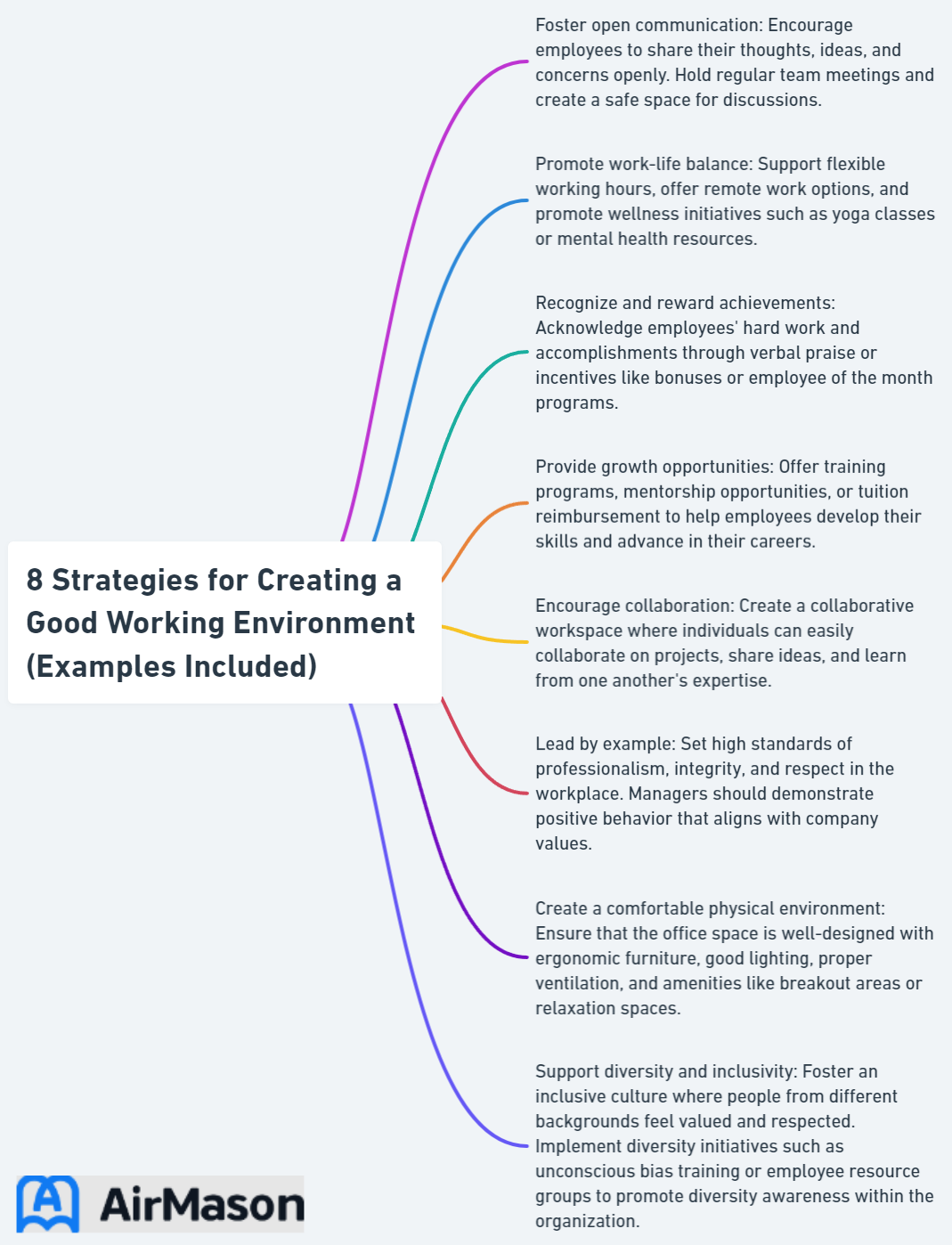
Did you know that a good work environment can significantly impact employee satisfaction, productivity, and overall business success? In today’s fast-paced and competitive world, creating a positive work environment is more important than ever. In this blog post, we’ll explore the various aspects that contribute to a healthy work environment and share some exciting good working environment examples of companies that have successfully implemented them. Let’s dive in and discover how to transform your workplace into a thriving and happy environment!
Key Takeaways
- Create a positive work environment to foster employee job satisfaction, productivity & success!
- Invest in the right tools, office layout and ergonomics for an improved experience.
- Open communication, trust & recognition are key psychological factors for an exciting workplace culture!
The Importance of a Good Work Environment
A positive work environment significantly influences job satisfaction, productivity, and overall business success. Workplace environments are made up of different layers, each with its own ingredients, such as:
- Office layout
- Communication styles
- Interpersonal relationships
- Organizational culture
Aside from the physical space and organizational culture, additional elements like flexible working hours and healthy work-life balance contribute to how employees feel in the workplace. In turn, this leads to a more engaged and motivated workforce, driving the growth of your business.
How can you transform your workspace into an amazing work environment? We’ll examine the physical and psychological aspects that contribute to an exceptional workplace.

An Organization’s Culture
An organization’s culture encompasses the shared values, beliefs, and behaviors that define its identity and guide the actions of its members. It serves as the invisible framework that shapes how individuals interact, make decisions, and contribute to the collective goals of the entity. This culture is not only reflected in written documents or formal policies but is embedded in the day-to-day operations and interactions within the organization. It influences how teams collaborate, how leaders lead, and how employees engage with their work. An organization’s culture plays a pivotal role in attracting and retaining talent, as individuals are naturally drawn to environments that resonate with their own values and aspirations. Furthermore, a healthy and well-defined culture fosters a sense of belonging and purpose among members, ultimately contributing to a more productive and harmonious work environment.
Physical Aspects of a Good Work Environment

A productive and positive working environment relies heavily on physical aspects like office layout, lighting, and ergonomics. These aspects contribute to employee comfort and well-being, ultimately affecting their performance. By investing in the right tools, equipment, and workspaces, you can create a healthy working environment where employees feel supported and motivated to give their best.
We’ll examine how these physical aspects can significantly impact your workplace.
Office Layout
An office layout should promote collaboration, focus, and comfort, taking into account employees’ needs and preferences. For example, an open office layout fosters communication and easy interaction among employees, creating a sense of openness and accessibility. On the other hand, a cubicle office layout offers privacy, storage space, and reduced distractions but may limit collaboration and natural light.
An office layout tailored to your team’s unique requirements inspires and engages employees.
Lighting and Temperature
Proper lighting and temperature control are crucial for a comfortable work environment that supports productivity and reduces stress. The optimal temperature for an office environment is generally considered to be between 20°C and 23°C (68°F and 73°F). In addition, adequate lighting helps prevent eye strain, fatigue, and headaches, making it an essential factor for employee well-being.
Providing suitable lighting and temperature conditions ensures a workspace where employees can excel.
Ergonomics
Ergonomics play a crucial role in employee health and comfort by improving the overall work experience. Investing in ergonomic furniture and equipment, such as adjustable chairs, standing desks, and ergonomic keyboards, can significantly impact employees’ physical well-being.
Workspaces prioritizing ergonomics not only benefit employee health but also foster a healthy work environment that is focused and productive.
Psychological Factors in a Good Work Environment

In addition to the physical aspects, psychological factors such as open communication, trust, and recognition play a vital role in creating a positive work environment. These factors foster employee engagement and satisfaction, encouraging a sense of belonging and commitment to the organization.
We’ll investigate how nurturing these psychological factors can cultivate a thriving work environment.
Open Communication
Open communication promotes transparency, collaboration, and a sense of belonging among employees. By encouraging open dialogue between employees and supervisors, you create an inviting and secure environment for employees to express their opinions and receive honest feedback. Examples of companies that have successfully implemented open communication in the workplace include Google, Salesforce, and Patagonia.
Cultivating open communication builds a work environment where employees feel validated, valued, and engaged.
Trust and Autonomy
Trust and autonomy empower employees to take ownership of their work and contribute to a positive work environment. When employees trust each other and their leaders, they feel more confident sharing ideas, asking for help, and taking risks, leading to increased innovation, productivity, and job satisfaction.
Fostering a work environment that values trust and autonomy develops a strong, cohesive team that excels in collaboration and creativity.
Recognition and Rewards
Recognizing and rewarding employees is essential for motivating them and reinforcing positive behaviors, leading to a more engaged and productive workforce. Recognition can come in various forms, such as incentive programs, acknowledging efforts during meetings, or simply through verbal affirmations with appreciation.
Regular recognition and rewards cultivate a work environment where employees feel valued, motivated, and inspired to excel.
They Don’t Know I Do It for the Culture
In a world where actions often speak louder than words, there’s a subtle but powerful force at play: “They don’t know I do it for the culture.” This mantra encapsulates a profound dedication to preserving, promoting, and celebrating the essence of a community, often unbeknownst to those observing from the sidelines. It’s a silent commitment that goes beyond personal gain or recognition, driven by a deep-seated belief in the transformative power of culture. Through small, deliberate acts and unwavering support, individuals who hold this ethos work tirelessly to ensure that traditions, art, and heritage continue to thrive. This devotion is a testament to the enduring influence of cultural roots and the quiet heroes who stand as its guardians, ensuring that future generations inherit a legacy steeped in the richness of their shared history. It’s a dedication that may go unnoticed, but its impact resonates far beyond the surface, leaving an indelible mark on the tapestry of human experience.
Examples of Good Work Environments

Several companies have successfully created good work environments by investing in employee well-being and satisfaction. Google, Salesforce, and Patagonia are prime examples of organizations that have implemented various strategies to promote a positive work environment, including fostering positive thinking among their employees.
We’ll examine the workplace practices these companies adopted to cultivate thriving work environments.
Google’s work environment is renowned for its unique and creative atmosphere, offering flexibility, creative freedom, and a fun environment. Their office design is cool and colorful, promoting a sense of play and inspiring creativity. Moreover, Google offers a range of benefits to its employees, such as healthcare benefits, work/life balance, parental leave, and free meals, which foster a positive and motivated work environment.
Google’s investment in employee well-being and satisfaction has resulted in an engaging and enjoyable work environment.
Salesforce
Salesforce is known for its incredible work environment, offering fantastic career opportunities, competitive compensation, and a focus on employee well-being and workplace culture. The company has implemented several initiatives and practices to create a positive work environment, such as focusing on ESG excellence, fostering employee well-being, and empowering leaders and teams in a hybrid work environment.
Salesforce’s commitment to employee well-being and sustainability has fostered a thriving work culture and enhanced employee engagement.
Patagonia
Patagonia promotes a positive work environment by embracing work flexibility, treating work as play, and encouraging activism and sustainability efforts. Their open office layout fosters collaboration and a sense of community among employees. Patagonia also offers flexible work arrangements such as remote work options and a 9/80 work schedule, giving employees a three-day weekend every other week.
Patagonia’s investment in their work environment has yielded remarkable benefits like improved employee retention, engagement, and a sustainability-focused culture.
Implementing Flexible Work Arrangements

Flexible work arrangements are an effective way to improve work-life balance and contribute to a positive work environment. By offering employees options such as remote work, flextime, and job sharing, you can create a more flexible work environment that caters to their individual needs and preferences.
We’ll examine how these flexible work arrangements can benefit both employees and organizations.
Remote Work
Remote work allows employees to:
- Work from anywhere
- Have flexibility and autonomy
- Foster a better work-life balance
- Alleviate stress associated with commuting and rigid schedules
Remote work can also lead to increased productivity, as employees have the freedom to work in an environment that suits their individual needs and preferences.
Flextime
Flextime provides employees with the following benefits:
- Freedom to choose their working hours
- Promotion of work-life balance
- Reduction of stress
- Effective schedule management
- Better balance between personal and professional lives
Flextime offers a more flexible work environment, bolstering employee well-being and productivity.
Job Sharing
Job sharing enables employees to:
- Share responsibilities and workload
- Offer flexibility
- Promote collaboration
- Maintain a better work-life balance
- Fulfill their professional duties
This innovative work arrangement allows employees to maintain a better work-life balance while still fulfilling their professional duties.
Implementing job sharing fosters a flexible and collaborative work environment that accommodates the diverse needs of your employees.
Why is Organizational Culture So Difficult to Change
Organizational culture’s difficult to change stems from its deeply ingrained nature within a company. It serves as the collective identity and shared values that bind employees together. Over time, these cultural elements become embedded in every facet of the organization, from the way tasks are accomplished to how decisions are made. This entrenched culture forms a comfort zone for employees, providing a sense of stability and predictability. When attempts are made to alter it, employees may face uncertainty and resistance, fearing disruption to their accustomed ways of working. Additionally, leaders may encounter resistance from longstanding traditions and established power structures that are intertwined with the existing culture. This resistance often requires a concerted and sustained effort, including clear communication, active involvement of employees, and a strategic approach to gradually introduce and integrate new cultural elements.
Building a Positive Company Culture
Building a positive company culture is crucial for creating a thriving work environment. This involves defining core values, encouraging collaboration, and supporting employee growth. By fostering a positive workplace culture, you can create a work environment where employees feel engaged, motivated, and valued.
We’ll examine the specifics of cultivating a positive company culture.
Defining Core Values
Clearly defined core values guide employee behavior and decision-making, contributing to a cohesive and positive work environment. These values help to establish a shared understanding of what is important and what is expected in the workplace, creating a sense of unity and purpose among employees.
Establishing and communicating your company’s core values fosters a strong organizational culture that aligns with your mission and goals.
Encouraging Collaboration
Encouraging collaboration fosters teamwork, innovation, and a sense of belonging among employees. By promoting open communication and shared decision-making, you can create an environment where employees feel comfortable sharing ideas, asking for help, and working together on projects.
Promoting a collaborative work environment nurtures innovation, creativity, and a strong sense of community among your employees.
Supporting Employee Growth
Supporting employee growth through training, mentorship, and development opportunities leads to a more skilled and engaged workforce. By investing in employee growth, you not only help your employees reach their full potential but also create an environment where they feel valued and motivated to contribute their best efforts. This, in turn, leads to increased productivity, innovation, and overall business success.
Tips for Creating a Good Work Environment

To sum up, creating a good work environment is essential for employee satisfaction, productivity, and overall business success. Some tips for creating a positive work environment include investing in employee well-being, promoting open communication, and fostering a positive company culture.
Focusing on both physical and psychological aspects cultivates a thriving work environment that underpins your employees and propels business growth.
Summary
In conclusion, a good work environment is the foundation for employee satisfaction, productivity, and overall business success. By investing in physical aspects such as office layout, lighting, and ergonomics, as well as psychological factors like open communication, trust, and recognition, you can create a thriving work environment that fosters employee engagement and satisfaction. Companies like Google, Salesforce, and Patagonia demonstrate the benefits of investing in employee well-being and satisfaction, showcasing the positive impact of a healthy work environment. Remember, a positive work environment is not only essential for your employees but also crucial for the success of your business.
Frequently Asked Questions
How would you describe a good work environment?
A good work environment is characterized by clear communication, effective teamwork, diversity, respect, commitment to employee well-being, and flexible schedules that support work/life balance. It should also foster trust, cooperation, safety, risk-taking support, accountability, and equity to promote productivity, creativity, and employee satisfaction.
What are the 3 most important things in a working environment?
Creating a respectful, collaborative and enriching work environment is key to achieving success in the workplace. Respect, teamwork, training and communication provide opportunity for growth and progress.
What is an example of a work environment?
The most popular work environment examples include traditional office environments, remote workspaces, and hybrid settings. Workspace can range from a cubicle, office space, or working remotely from home.
What are the key elements of a good work environment?
A good work environment requires the right physical setup, along with open communication, trust, and recognition to foster a productive and successful atmosphere.
How can a positive work environment impact business success?
A positive work environment boosts employee satisfaction, increases productivity and ultimately leads to success for the business.